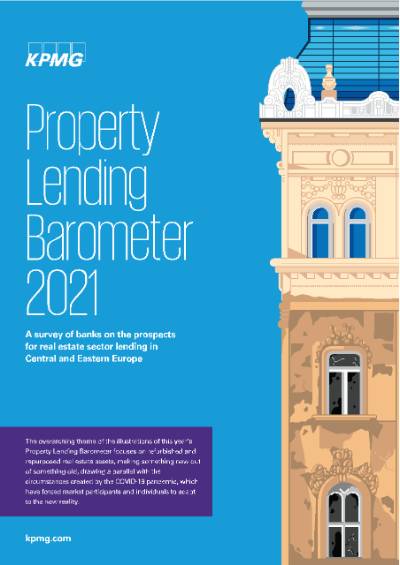Investments in property in CEE were down by a whopping 22% in H1 2021 compared to the same period a year earlier, which may come as no surprise, given the economic repercussions of the COVID-19 pandemic on most sectors.
Real estate development, investment and lending have taken a beating due to the pandemic's effects, but, according to the results of our latest Property Lending Barometer (PLB)1, property lending has gained increased importance for banks in 2021, while on the one hand real estate loan portfolios are deteriorating, and, on the other, market conditions continue to gradually improve. Moreover, the tougher times mean that lending institutions within the region can pick and choose what types of investments to grant loans to under stricter terms and conditions.
This year’s edition of KPMG's survey included over 40 participating lending institutions across 11 CEE markets who provided their responses to questions about their level of impaired loans, importance of real estate as part of the bank’s lending strategy, their average loan size and other preferences. For this 12th edition of the PLB, KPMG collected data via online questionnaires and through in-depth interviews with bank representatives in May- June 2021.
COVID continues to exert influence on property markets
Property transactions in CEE totalled EUR 4.9 billion for H1 2021, with 80% of that coming from three countries: over half attributable to Poland (53%), followed by the Czech Republic and Hungary, at 18% and 13%, respectively. Slovakia, Romania, and Hungary continued to grow in H1, while Bulgaria and the Czech Republic saw the steepest drops in investment activity, year on year.
The survey was conducted in never-before-seen times for the global economy, given the continued effects of COVID-19. According to the PLB survey participants, the global pandemic continues to affect property lending and it also has the highest influence over investment decisions, such as determining what sort of property developments are likely/unlikely to receive funding.
Bank representatives also revealed that although sustainability is currently a hot topic among real estate professionals and one which is mentioned frequently at industry events focusing on the future of the real estate industry, it is still not a key factor when considering the financing of a real estate asset.
Residential assets overtake industrial/logistics segment
According to our respondents the residential assets have become the most attractive class for the majority of banks in the region a year since the breakout of the COVID-19 pandemic, overtaking the industrial/logistics segment, which, in the throes of the pandemic overtook the office asset class in 2020.
Head of KPMG’s Real Estate practice in CEE, Andrea Sartori explains that even though property development in Europe is steeped in an uncertain environment due to the continuing effects of the global health crisis, most banks in the region that participated in the survey have increased their focus on lending to real estate compared to last year. Ultimately, this translates into banks looking for more “sure things” when it comes to what they're willing to finance.
He offers: “Compared to last year's results, not only are we seeing a continued openness to finance income-generating projects, but more banks within the CEE region are willing to fund new developments; unsurprisingly, and consistently with past surveys, the former typically receives more favourable terms than the latter – which shows the importance of eliminating development and market entry risk.”
Another big change seen in this year's survey, according to Mr Sartori, is the emergence of the residential segment as the most popular asset class in several countries, with industrial/logistics coming in 2nd place, according to the bank representatives who responded to KPMG's survey.
“This is perhaps no surprise,” he says, “as it's obviously a consequence of the pandemic on how people are doing business – in both our region and around the world: either completely from home or going into offices on an irregular basis. That's not only been a shock to the office segment, but has meant that residential is in focus, overall, for societies themselves – all of our homes are now dual purpose: serving both home and work life.”
Last year, Mr Sartori notes, logistics got a huge boost (and was at the top of last year's PLB) from lockdown times during the pandemic when consumers were having every product imaginable delivered to their homes rather than visiting shopping malls. What still has to be assessed is whether or not certain recent trends, such as working from home and replacing physical shopping with online shopping, at least partially, will become regular habits of people living in the CEE.
KPMG's Property Lending Barometer also includes detailed information on respondents’ indicated LTC and LTV ratio expectations, their pre-let and DSCR and interest premium expectations.
For more individual market specifics as well as insights on the future of real estate lending this year check the Property Lending Barometer 2021.
____
1 KPMG’s Property Lending Barometer is an annual study by the global audit and advisory firm which measures banks’ lending sentiments in CEE property markets
Zdravko Moskov
Partner, Advisory
KPMG in Bulgaria

